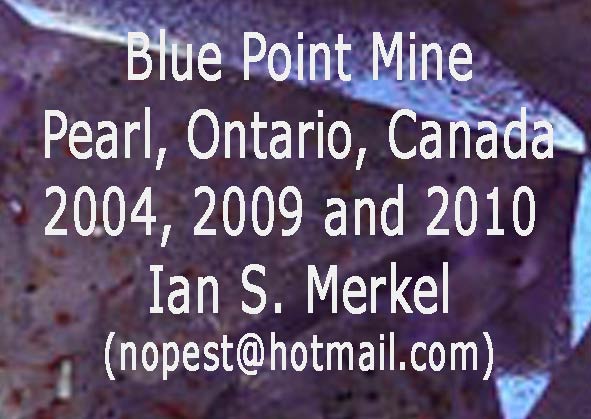Background
The Blue Point amethyst mine is located 35 miles east of Thunder Bay, Ontario, Canada along Highway 11/17. The mine is owned and operated by Linden Swanson, who lives on-site during operating months. The deposit is situated along a east-west striking fault contact between crystalline granitic rocks and sedimentary mudstones. The actively worked deposit is composed of a central quartz breccia with steeply dipping sub-parallel veins flanking the south side of the breccia in the mudstone (figure 1). Minerals occurring and observed by the author at this deposit include: amethyst, colorless quartz, hematite (and presumably other FeOx minerals) as inclusions (figure 2), barite, calcite, sphalerite and chalcopyrite, although none of the sulfides have been observed in vugs by the author. Amethyst, with or without inclusions, is the only mineral of interest and abundance that is collected. Calcite is not very common and all observed crystals were heavily frosted. Barite occurs as milky white and cream and is very brittle, likely as a result of hydrothermal damage. Barite occurs as precipitations upon the amethyst and no intact collectable crystals have been collected or observed by the author due to its brittle nature (figure 3).
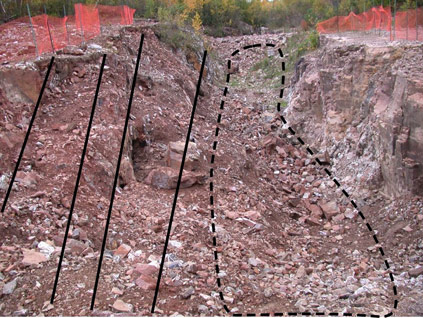
Figure 1. View of the west end of mine. Straight lines are approximate traces of sub-parallel vein set and dashed outline is the approximate area of the breccia zone. Width of cut is approximately 30 feet.

Figure 2. View of pale amethyst crystals in stereoscope showing spheres of variously colored FeOx minerals. Field of view is approximately 5mm.
| |
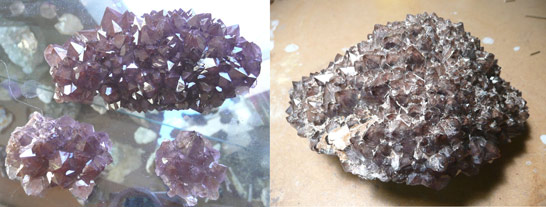
Figure 3. Two images of four specimens, all from the same pocket, from the sub-parallel vein zone. The specimen on the right is partially encrusted with barite, whereas the three specimens on the left are mostly devoid of barite with the specimen in the lower left corner being partially encrusted with barite. The large specimen in the left hand photo is 13 cm across; the specimen in the right hand photo is 18cm across.
|
Mining
Mining at the Blue Point mine is accomplished through drilling and blasting followed by working the resulting fractures with wedges, chisels and sledgehammers. The owner allowed my group to work fractures in the breccia zone from his blasting that were not in the immediate area of the pit that he was working (figure 4).
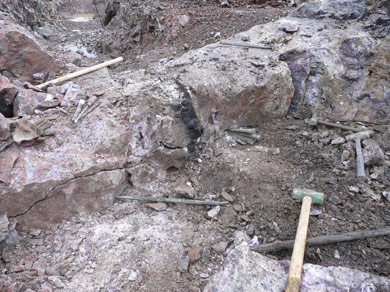
Figure 4. Area of breccia zone mined by author in 2009. This area was fractured during blasting prior to the authors arrival to the mine. Working the breccia without blasting is very challenging because of the hardness and coherent nature of this zone. The volume of rocks removed during the “lift” shown in the picture uncovered about 12 pockets ranging in size from a few centimeters to 45 centimeters.
|
Collecting Trips
Three collecting trips were made to the Blue Point mine by the author with friends: August 2004, August 2009 and September 2010. The 2004 trip was a one day spontaneous visit that resulted in the discovery of one significant pocket in the breccia zone. The two subsequent trips both entailed three days, more tools and significantly more pockets.
The sub-parallel veins are relatively easy to work with hand tools because the mudstone is relatively soft and highly fractured (figure 5). I have encountered two major pockets and a dozen plus smaller pockets in this zone. The first major pocket was mined in September 2009 and was approximately 4’ by 4’ by 8” (figure 6). The second major pocket in this area was mined during the 2010 trip. This pocket was approximately 6’ by 3’ by 8” (figure 5). These types of pockets are very easy to collect from as they are partially filled with pocket clay (figure 7) and the vein material is typically loose in the cavities, having spalled from the walls some time earlier (significantly earlier as suggested by the layer of FeOx on the backs of these pieces). The pieces that have not naturally spalled from the walls can usually be removed with ease by gently driving a screw driver between the specimens and the wall. The exception to this are the corners of the vugs where the specimens are continuous with the massive quartz seam filling. Here they need to be extracted with hammers and cold chisels.
Mining the breccia zone has only been possible if it has been fractured by blasting. The pockets in this zone are irregularly shaped and seem to be irregular in their occurrence. One pocket was collected in 2004 and many pockets were collected in 2009. During the 2010 trip this zone was worked minimally with effectively no success.
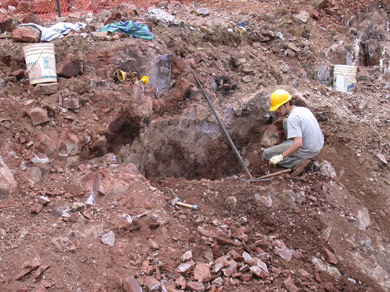
Figure 5. Author working the large pocket of 2010 in the sub-parallel vein zone. The array of hand tools utilized during mining can be observed surrounding the author. 5 gallon buckets are used to haul the specimens out of the mine. Pocket clay is included to protect the specimens in the buckets and any specimen that appears exceptional is individually packed out to ensure its preservation.
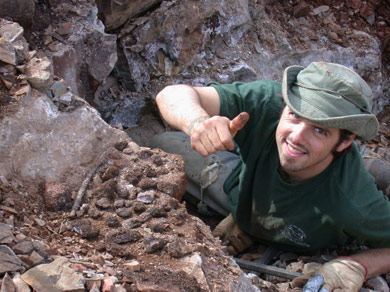
Figure 6. Author in the sub-parallel vein zone in 2009. Freshly collected material is visible to the author’s right. The large pocket is mostly out of sight to the author’s right and below the ledge the freshly collected specimens are sitting on.
| |
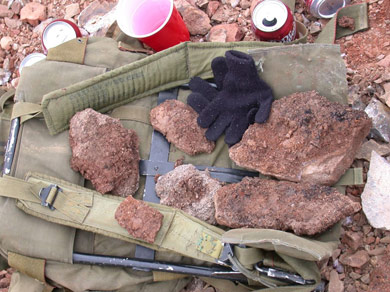
Figure 7. Six freshly collected specimens, still coated in pocket clay, awaiting individual wrapping before their removal from the mine.
|
Specimens
The majority of specimens from the pockets in the sub-parallel vein zone are flat plates (figure 8), although 3-dimensional crystal coated protrusions are common. Another important aspect of specimens from this zone is the occurrence of secondary quartz. The secondary quartz occurs as fine “dust” preferentially accumulated on one side of the specimen (figure 9), presumably on the leeward side of fluid flow. Another aspect of specimens from this area is because of the relatively narrow width of the pockets combined with the loose nature of the specimens. The specimens accumulate on the bottoms of the pockets in piles or become locked in place touching each other. The latter situation, due to the narrow width of the pockets, results in the tips of crystals commonly being damaged, typically on or near the highest point of the 3-dimensional specimens (figure 10). This is frustrating and unfortunate but a reality of the veins. The crystals in both of these major pockets are very similar. They are small, averaging about 4mm and up to about 10mm, and are heavily included with spheres and disks of various FeOx minerals (figure 2). The inclusions impart a maroon color to the crystals (figure 11). Back-lighting thin specimens brings out the amethyst coloration (figure 12). Smaller pockets are often encountered in smaller sub-parallel veins while excavating. The crystals in these are often variable and quite interesting (figure 13).
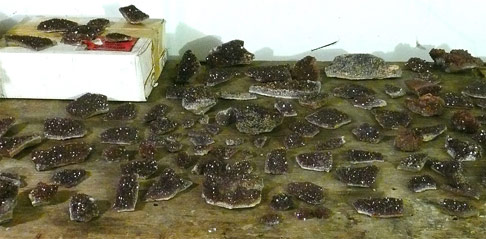
Figure 8. Workbench in author’s basement (reason for low light) covered with cleaned specimens from the 2010 trip. The white box is about 10 cm high.
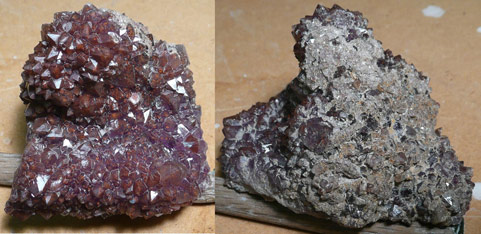
Figure 9. Two sides of the same specimen collected in 2010 from the sub-parallel vein zone. The secondary silica are small crystallized shards showing euhedral faces under high magnification. Specimen is 7 cm high.
| |
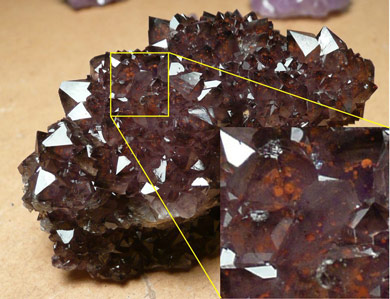
Figure 10. 3-dimensional amethyst dome from the large 2009 pocket in the sub-parallel vein zone. Inset area illustrates a few dings that were especially common on the tops of specimens from that pocket
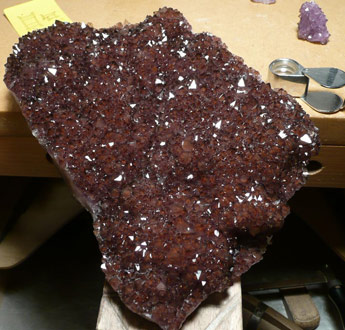
Figure 11. 20 cm plate of amethyst, colored maroon due to high concentrations of hematite inclusions; from the large 2009 pocket in the sub-parallel vein zone. A small specimen recovered in 2009 from the breccia zone can be seen in the background.
| |
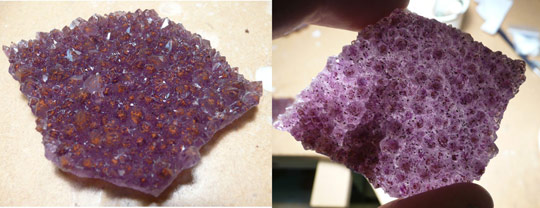
Figure 12. 5 cm specimen recovered from the 2010 pocket. The image on the left is lit from the front and illustrates the hematite inclusions whereas the right-hand image is the same specimen lit from behind.
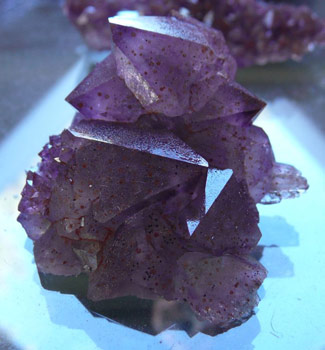
Figure 13. 4 cm specimen of amethyst with hematite inclusions recovered from an isolated pocket in a parallel vein. This specimen is unique with its mottled luster and bi-modal crystal size. The small crystals observed on the sides of the specimen in this view continue unobstructed on the backside.
| |
The breccia zone is very tight and large non-fractured blocks occur. Because of the lack of fractures, the vugs encountered in the breccia are of superior quality. Two attributes of the specimens from this zone impart the more desirable nature of these specimens. Firstly, the secondary quartz “dust” has never been observed in the vugs of this zone. Secondly, the concentration of inclusions is commonly less, allowing the amethyst coloration to show through without the necessity to be back-lit (figure 14). However, some pockets contain so little FeOx inclusions that they almost loose their diagnostic attributes that allow for easy identification as “Thunder Bay” amethyst (figure 15). The pockets of the breccia zone are also nearly free of secondary limonitic overgrowths, as opposed to the material from the sub-parallel veins, which all need to be cleaned with Fe-removing solutions (figure 16).
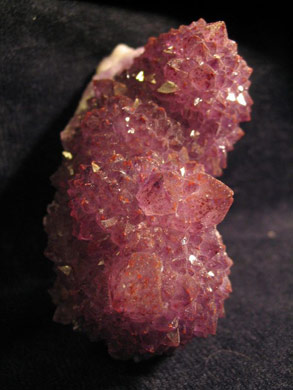
Figure 14. 8 cm high specimen from the breccia zone, collected in 2004, showing the classic hematite inclusions this mine is famous for.
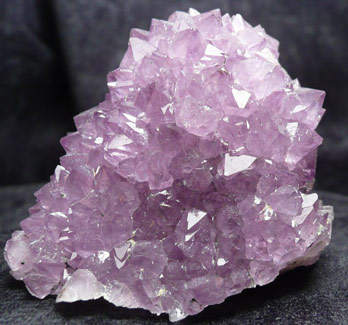
Figure 15. 5.5 cm high specimen collected from the breccia zone in 2009. This came from the largest pockets, about 45 cm long, and contained dozens of “purple turtles”.
| |
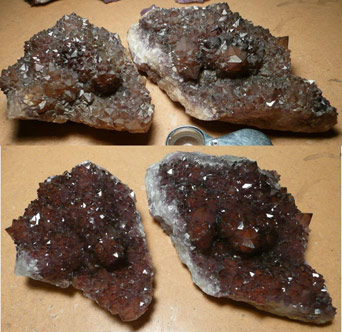
Figure 16. Two specimens, from the sub-parallel vein zone collected in 2009, before and after being soaked in a solution to remove the limonitic film. Specimens are about 13 and 15 cm, respectively.
|
A common occurrence in both types of veins at the Blue Point mine are 3-dimensional domes of crystals called by names such as: turtle backs, spiky balls and back-scratchers (figure 17). They are common enough that my friend and I have discussed a more apt name for the mine to be the “Purple Turtle”. These specimens are my sought after treasure whenever I open a pocket. The occurrence of the these in both types of pockets in interesting, not only because of their occurrence, which argues for similar intrinsic parameters of formation despite the clearly different geometry of the veins (i.e fluid chemistry P-T conditions?), but also because of their method of collecting. After their formation they were “popped” from their matrix. The broken surfaces of the “turtle backs” and the matrix pieces were then “healed” with a second generation of quartz (figure 18 and figure 19). This generation of quartz, as observed thus far, always lacks FeOx inclusions and also coats the primary amethyst crystals and lacks the amethyst coloration. Because of this, the turtle backs typically are collected with little effort once the pockets are opened, they only need to be removed from the pocket clay.
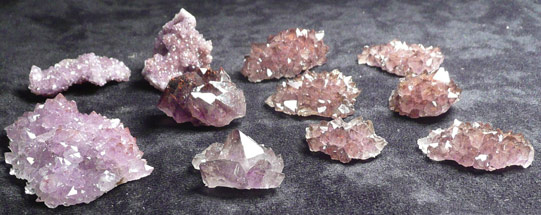
Figure 17. A suite of “turtle backs” collected in 2009 from various pockets in both zones.
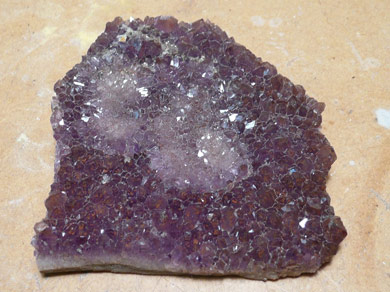
Figure 18. 9 cm specimen from the sub-parallel vein zone that illustrates the process by which the “turtle backs” were attached to their matrix. The pale lavender area in the upper left is where a “turtle back” was attached and is now re-crystallized.
| |

Figure 19. Front and back images of two 3.5 and 4 cm “turtle backs” (neither of which was attached to the matrix specimen in figure 18). The back image shows the re-crystallized texture that mirrors the texture illustrated in figure 19.
|
Collecting Accessibility
The pit was open to any collector for my first two trips. The owner only charged a per-bucket fee for whatever material is removed from the property. Many people who visit the mine simply purchase “yard rock” specimens from him on a per rock charge (figure 20). The situation during my 2010 trip indicates the changes that will be occurring in the future. The Canadian mining authorities have asked the owner to start regulating who is allowed into the actual pit and what personal protective equipment they must wear. Mr. Swanson tells me that going forward casual collectors will not be allowed into the pit. Anyone who wishes to actually mine using tools will be required to take a Canadian certification course. My friend and I were let in this year because the rules are still fuzzy and Mr. Swanson considered us “qualified”. I will find out in the near future how these laws evolve.

Figure 20. Rocks like this litter the mine and are generated by opening pockets. The small size of the cavity in this picture makes it hard to remove a crystal specimen intact, therefore these types of rocks are typically put to the side to be preserved as garden rocks, and the loose or easily removed portions are taken as specimens.
|
CLICK THE LITTLE MINER TO RETURN TO THE FIELD TRIP PAGE

